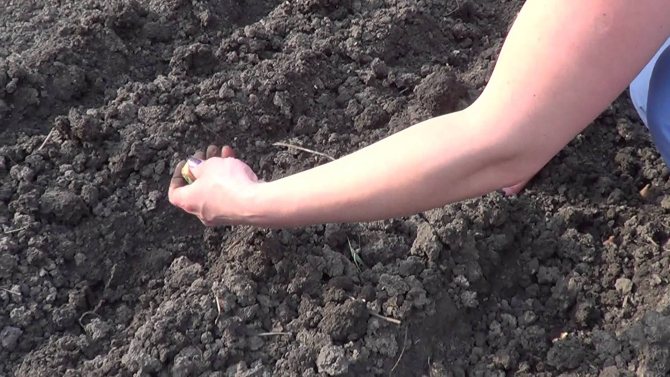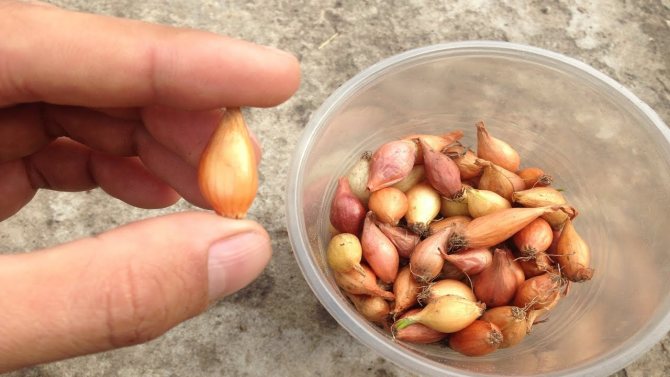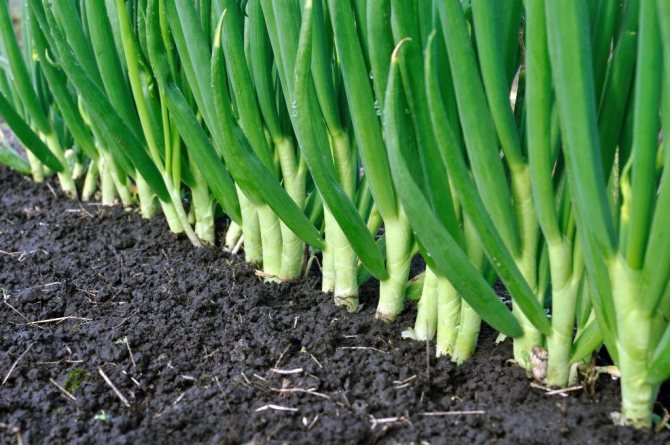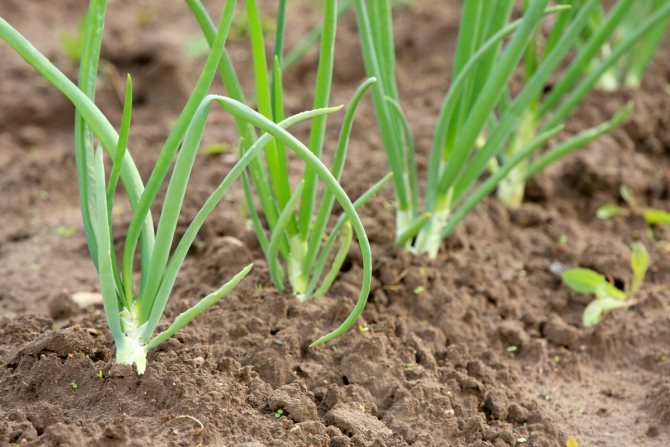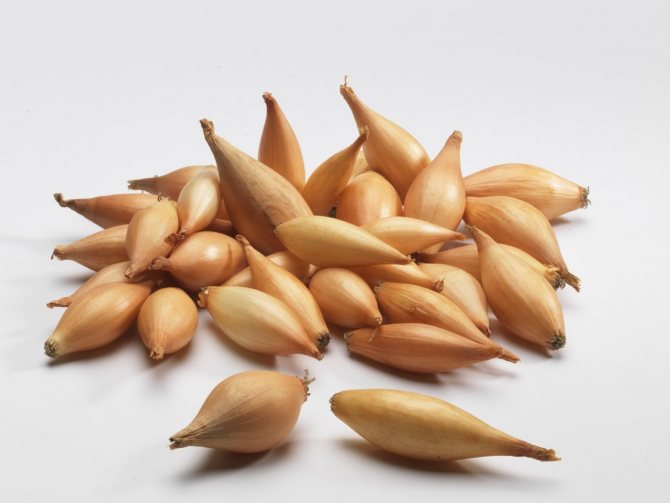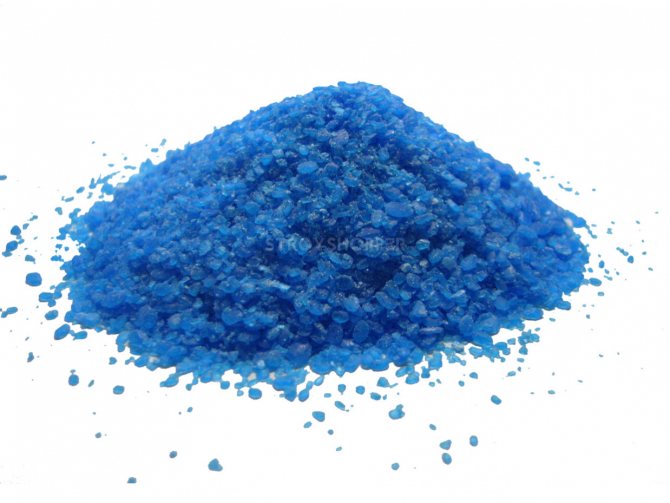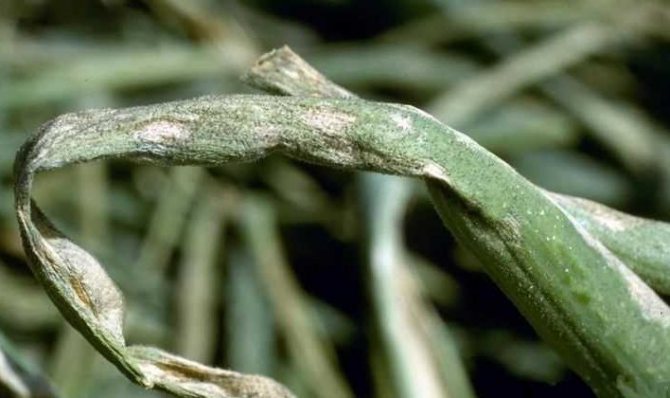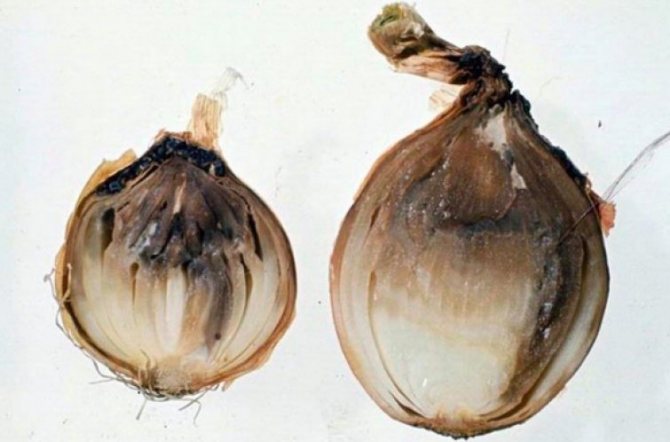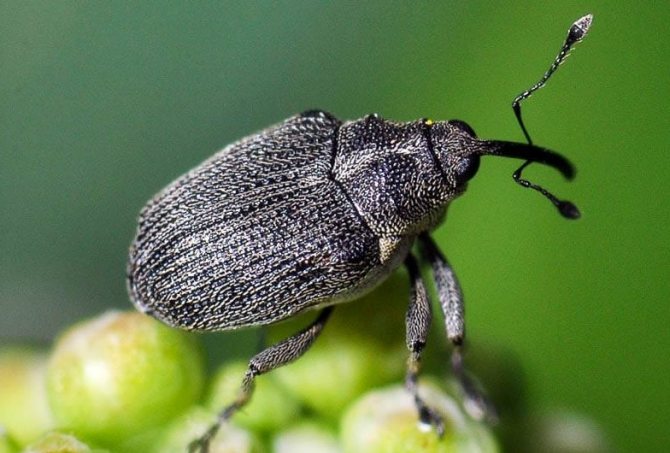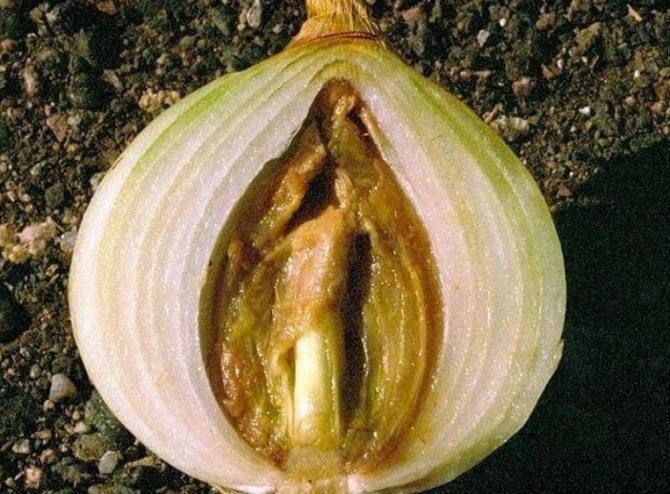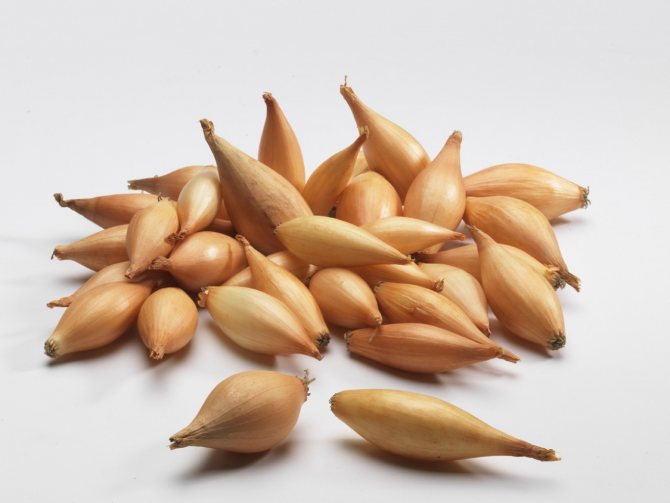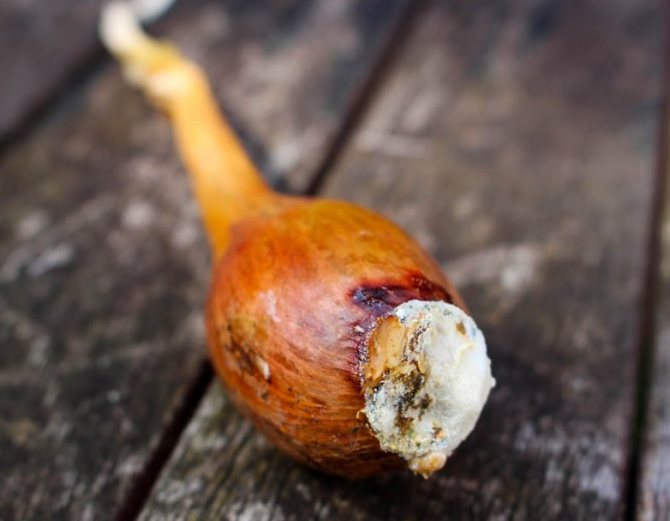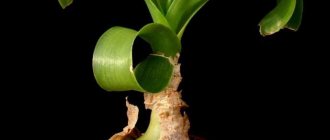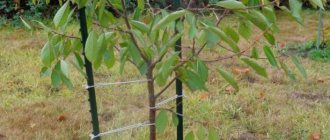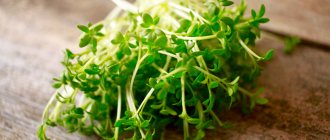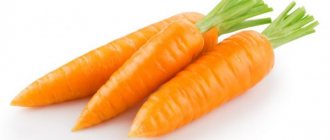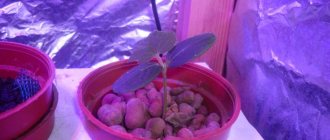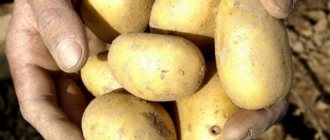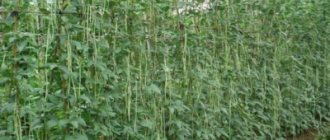Bamberger onions imported from the Netherlands are suitable for cultivation in all Russian territories, including the Urals and Siberia. Its unpretentiousness and productivity attract the attention of most gardeners in the country.
- 1 Description of Bamberger onions
- 2 Advantages and disadvantages of the variety
- 3 Video "Preparing the Bamberger bow for planting"
- 4 Agrotechnics of Bamberger onions 4.1 Preparation of planting material
- 4.2 Landing features
- 4.3 Care instructions
Description of the variety
The Bamberger variety is characterized by an elongated shape of bulbs, a mild taste and a bright aroma. This onion can be eaten fresh, added to hot dishes, salads and preserves.
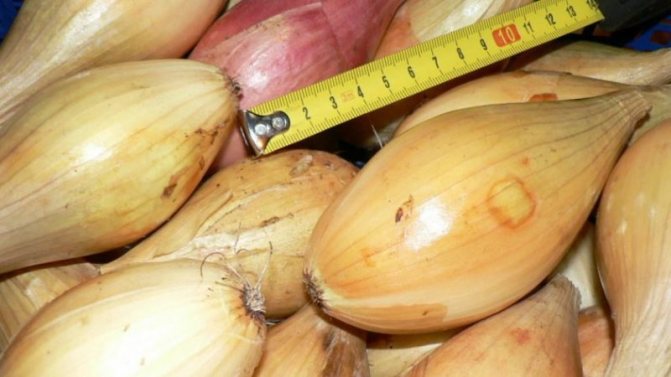
Origin and development
Bamberger onions were bred by Dutch breeders. This is a relatively young variety - it began to be actively cultivated only in the 21st century.
Chemical composition, trace elements and vitamins, useful properties
Onions contain:
- proteins fats carbohydrates;
- mono - and disaccharides;
- alimentary fiber;
- vitamins A, C, E, PP and group B;
- essential oils;
- potassium, calcium, phosphorus, iron, fluorine;
- flavonoids with antioxidant action.
The vegetable is useful for colds, since it is able to fight inflammation and destroy bacteria, has a beneficial effect on blood vessels and blood composition, helps to strengthen the intestines and helps in the treatment of the liver.
Ripening period and yield
Medium early variety. The crop is ready for harvest approximately 90 days after planting, i.e. in late August or early September.
The maximum yield of Bamberger is observed when planting onion sets - from 1 sq. m collect about 6 kg.
Disease resistance
The variety is resistant to:
- powdery mildew;
- rot;
- thrips;
- onion nematode and flies.
The Dutch onion set has a high immunity, but the planting material from Chuvashia is less resistant to diseases, pests and frost, although it is cheaper.
Characteristics of the bulb, description of appearance, taste
The bulbs are elongated, slightly elongated, small - they grow up to 10 cm in length and weigh an average of 60-80 g. Covered with yellow-brown husk. The pulp is snow-white, juicy with a slightly sweetish, but not sugary taste. The pungency is more in the aroma than in the taste.
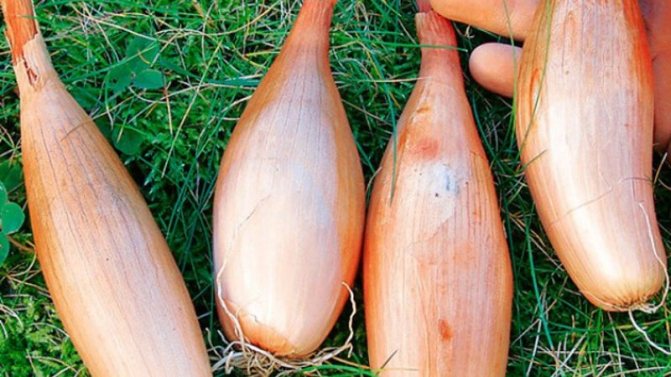

Growing regions and climate requirements
The Bamberger variety is unpretentious to climatic conditions and is successfully cultivated in almost all regions of the country.
Reproduction methods
This is best done with sevkom. Before sowing, the material is sorted, dried, diseased and rotten bulbs are removed. The sorted material is divided into three groups, by faction.
The sets set aside for planting are dried for several days, then warmed up. Before planting, you should also soak the seedlings in warm water with the addition of manganese to protect the planting material from diseases. After that, the seed is washed out and can be considered ready for planting.
Read more: Does the winter maintenance of guinea fowls rush in winter?
Experts assure that the smallest fraction of seedlings is best suited for planting, as it produces the highest yields.
The sets set aside for planting are dried for several days, then warmed up.Before planting, you should also soak the seedlings in warm water with the addition of manganese to protect the planting material from diseases. After that, the seed is washed out and can be considered ready for planting.
Advantages and disadvantages
The main advantages of the variety:
- long-term storage;
- high productivity;
- unpretentious care;
- disease and pest resistance;
- versatility of use;
- soft, sweetish taste;
- lack of shooting;
- the ability to grow in various climatic conditions.
Disadvantages:
- tendency to peel off during storage;
- acrid smell.
Difference from other varieties
Comparative table of Bamberger with other onion varieties:
| Variety | Ripening period | Bulb shape | Taste | Bulb weight, g | Productivity, kg / sq. m |
| Bamberger | About 90 days | Elongated, slightly elongated | Sweetish | 60-80 | 6 |
| Chalcedony | 110-120 days | Rounded | Acute | 90-130 | 2-6 |
| Alvina | 95-105 days | Flat | Semi-sharp | 60-80 | 1,5-3 |
| Luhansk | 120-130 days | Rounded oval | Acute | 70-150 | 1,5-4,5 |
Yield
The taste of Bamberger onions ranges from sweet to mildly spicy. Fruits are juicy, rounded-elongated, due to which onions are actively used in cooking.


Fresh salads are prepared from Bamberger onions, they are added to various winter preserves and pickled assortments with vegetables.
The crop is obtained from this variety even, uniform, onions are almost all the same size, about 80 grams each. If the set has been correctly selected, then the shooter practically does not throw out.
Onions are harvested in the middle or early stages: mid-August or early September. The crop is dried for several days in the sun or under a canopy until the neck dries out and golden scales appear. Then they are cut off, leaving a stump of 2-3 cm, and placed in storage boxes.
Bamberger Gold Bow
When the soil begins to crack at the base of the plants, it indicates that the ripening of the bulbs has begun. From this point on, the use of fertilizers should be discontinued. You do not need to huddle this vegetable, as the bulbs ripen better if they are on the surface of the soil. When the onion heads are ripe, the leaves will begin to turn yellow and fall off. After a few days, the bulbs can be pulled out of the soil and left on the surface to begin the hardening process.
Important! The damaged bulb should be eaten immediately, as it will not be well stored.
After that, the turnip is shaken off the dried earth and transferred to dry for two weeks under a shed or in a barn. The recommended storage temperature for the harvest of Bamberger onions varies in the range of 3 ... 10 ° C, and the air humidity is in the range of 70%. It is not recommended to mix Bamberger with other onions during storage, as this can reduce storage time. If there is no special storage for vegetables, then this onion can be successfully stored on the loggia.
Ripe onions can be harvested from mid-August. The turnips are dug up, dried under a canopy for a couple of days, until the scales turn yellow and the necks dry out.


The onion is moved, foliage and roots are cut off. The harvested crop is put into storage.
The Bamberger variety is considered unpretentious to grow. If the planting material has been prepared with high quality, the soil composition is suitable for acidity, proper care is organized - the harvest is guaranteed.
Features of planting and growing
The quality and quantity of the crop depends on many factors, including the correct preparation of planting material and soil and compliance with the timing of planting onions.
Pre-sowing preparation
The purchased onion sets are laid out for 2-3 weeks in a warm room at a temperature of + 20 ... + 22 ° C with good ventilation for drying. This helps to avoid rotting the bulbs from the inside.
To eliminate arrowheading, to kill spores of fungi that may be present on the surface, and to accelerate the formation of green leaves and roots, 24 hours before planting, the bulbs are warmed up:
- the seed is placed in a container of a suitable volume;
- pour water heated to + 35 ... + 40 ° C;
- close the container with a lid, wrap it up and leave for 5-6 hours.
Reference. For additional disinfection, the seedlings are soaked for 20-40 minutes in a solution of potassium permanganate or copper sulfate.
The soil is prepared in the fall: cleaned of weeds, treated with copper sulfate (diluted 1 tbsp. L. Funds in 10 liters of water and watered the ground at the rate of 1-1.5 liters per 1 sq. M.), And watered abundantly before frost.
In the spring, the soil is fertilized. Mineral or organic fertilizing is chosen depending on the type of soil:
- loams: 3-4 kg of humus, 5 kg of peat, 2 tbsp. l. superphosphate and 1 tsp. urea per 1 sq. m;
- clay soil: 6 kg of humus and peat, 1 tsp. urea and 1 tbsp. l. superphosphate per 1 sq. m;
- peat bogs: 5 kg of compost or humus, 1 tsp. urea and 1 tbsp. l. "Nitrofoski" and superphosphate per 1 sq. m;
- sandstones: 10 liters of compost or humus, 2 tbsp. l. superphosphate, 1 tbsp. l. "Agricola" and 20 liters of loamy or clay soil per 1 sq. m.
The beds are dug onto a shovel bayonet, then covered with foil and left for 5-6 days.
Ground requirements
Bamberger prefers light, fertile soil with good aeration and moisture permeability. The permissible acidity for mineral soil is pH 6.5-7, for peat soil - 5.5-6.5.
Timing, scheme and landing rules
There are two options for planting sevka Bamberger: subwinter (in the third decade of October) and spring, when the soil warms up to + 10 ° C (in mid-April - early May).
Landing before winter:
- Prepare the beds at a distance of 25-30 cm from each other.
- Make planting furrows in them 8-10 cm deep.
- Place the bulbs in the furrows so that the distance between them is about 10 cm.
- With the onset of stable frosts, cover the beds with a thick (10-15 cm) layer of hay, straw, fallen leaves or sawdust.
After the snow melts, the mulch layer is removed from the garden. This is usually done in the second decade of March, but if frosts continue, the mulch is left until they pass.
When the soil dries up, it is loosened. Shortly thereafter, onion feathers emerge from the soil.
For spring planting, they dig up the earth on a half bayonet of a shovel and level it with a rake. Next you need to:
- Prepare beds with a distance of 25-30 cm between them.
- Make planting furrows in them 3-5 cm deep.
- Water the furrows 30 minutes before planting the seedlings (1 liter of water per 1 m of the furrow).
In the spring, you can also sow onion seeds, after soaking them for a day in a solution of a growth stimulant, for example, "Epina".
Growing features
The planting site for Bamberger bows should be well lit, protected from gusty winds and located on a low hill. In the lowlands, moisture often stagnates, which provokes rotting of the bottom of the onion.
It is important to take into account the rules of crop rotation: peas, soybeans, beets, cabbage and cereals are considered the best predecessors of onions.
Reference. Onions can be planted in the same place once every 3-4 years.
Bamberger bow is unpretentious in care. At the same time, compliance with the basic agrotechnical norms and rules is necessary for him in the same way as for other varieties.
Watering mode
The need for irrigation is determined by the condition of the soil: it is watered when it is completely dry to a depth of 10 cm.
The procedure is carried out in the morning, because during the evening watering the onion will not have time to dry out completely, and the accumulation of moisture on the leaves leads to the development of fungal diseases.
Particularly abundant watering - every 2-3 days - is required during the month of cultivation. Then it is gradually reduced - up to 1 time in 10 days. 2-3 weeks before harvesting, they stop completely so that the onions ripen well.
Loosening the soil and weeding
The soil is loosened and weeded every 10-14 days or more.It depends on the growth rate of the weed.
Loosening improves oxygen access to the bulbs, which has a positive effect on the quality and quantity of the crop. Removing weeds is necessary to ensure that they do not take nutrients from the soil.
Important! Mulch-covered beds do not need these treatments.
Top dressing
Fertilizers are applied three times according to the following scheme:
- 14 days after planting onions - a solution of chicken droppings at the rate of 10 liters per 1 sq. m;
- after 3-4 weeks - nitrogen-containing top dressing;
- after another 3-4 weeks - potash fertilizers.
Disease and pest control
To prevent the development of diseases and attacks of pests, plants need to be treated with copper chloroxide during active growth or copper sulfate, when the length of the feathers reaches 15-20 cm.
Growing difficulties
When cultivating this variety, the following problems may arise:
- throwing seed arrows when planting onions in cold ground;
- drying and lodging of feathers due to non-observance of the rules of agricultural technology (shallow planting of seedlings, lack of nitrogen in the soil, lack of lighting);
- yellowing and drying of leaves due to the attack of onion flies.
Harvesting and storage
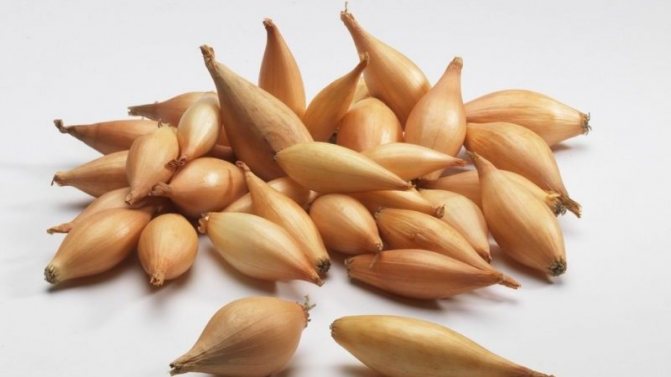

The ripening of the onion heads is evidenced by the lodging of the feathers.
How and when to collect
The crop is harvested in August - September, carefully digging in the bulbs with a shovel and pulling them out of the ground with your hands.
Features of storage and keeping quality of the variety
After harvesting, the onions are dried in a well-ventilated room at an air temperature of + 30 ° C.
After drying, the roots are cut off and the bulbs are carefully examined: too small are set aside for early use, and the spoiled ones are thrown away.
For storage, onions are placed in wooden or plastic boxes with ventilation holes, wicker baskets or mesh bags and taken to a dark, ventilated room, where the humidity is 70% and the air temperature is + 3 ... + 10 ° C.
Important! Containers with onions are placed on shelves or pallets. Do not store crops on the floor or near walls.
Subject to the necessary conditions, the onion is stored until the new harvest, practically does not deteriorate and does not germinate.
Tips from experienced gardeners
Farmer tips for growing Bamberger:
- Fill up the soil between the rows with mulch. This will help avoid damage to the bulbs and leaves during tillage and minimize the risk of developing some bacterial diseases.
- Cover newly planted plants with agrofibre or spunbond to keep them warm. In addition, the non-woven fabric hides the smell of onions from pests.
- Plant carrots nearby to ward off onion pests.
Reviews of the Bamberger onion variety
You can get a more realistic idea of the Bamberger onion by reading the reviews of gardeners.
Maria, Tula: “I don't like bitter onions, so I was looking for a variety with a sweet taste. Another selection criterion was a high yield with minimal maintenance, since I can only go to the dacha on weekends. As a result, I settled on the Bamberger variety and did not regret it, I have been growing it for 5 years. I like that it is unpretentious and fruitful, and, moreover, it can be stored perfectly - practically until the next harvest without losing its taste. "
Timofey, Bryansk: “I have a long experience as a gardener, I have grown many different varieties of onions, so there is something to compare with. I can say for sure that a completely newbie will cope with Bamberger - the variety is not capricious, it grows almost by itself, while the yield is excellent. I experimented with planting times - winter crops tasted much better. "
Care rules


After finishing planting, the beds should be mulched. This measure will make it possible to artificially organize conditions for long-term moistening of the soil composition, if a dry period occurs or it is not possible to organize regular watering.
Young sprouts of bamberger onion
When the first sprouts appear, the onions should be fed. As a rule, complex mineral components, cow dung, are used for this.
Regular watering is one of the main growing conditions. In the first two months, this procedure should be carried out in moderate doses, while the soil in the beds should be loosened.
After finishing planting, the beds should be mulched. This measure will make it possible to artificially organize conditions for long-term moistening of the soil composition, if a dry period occurs or it is not possible to organize regular watering.
Young sprouts of bamberger onion

